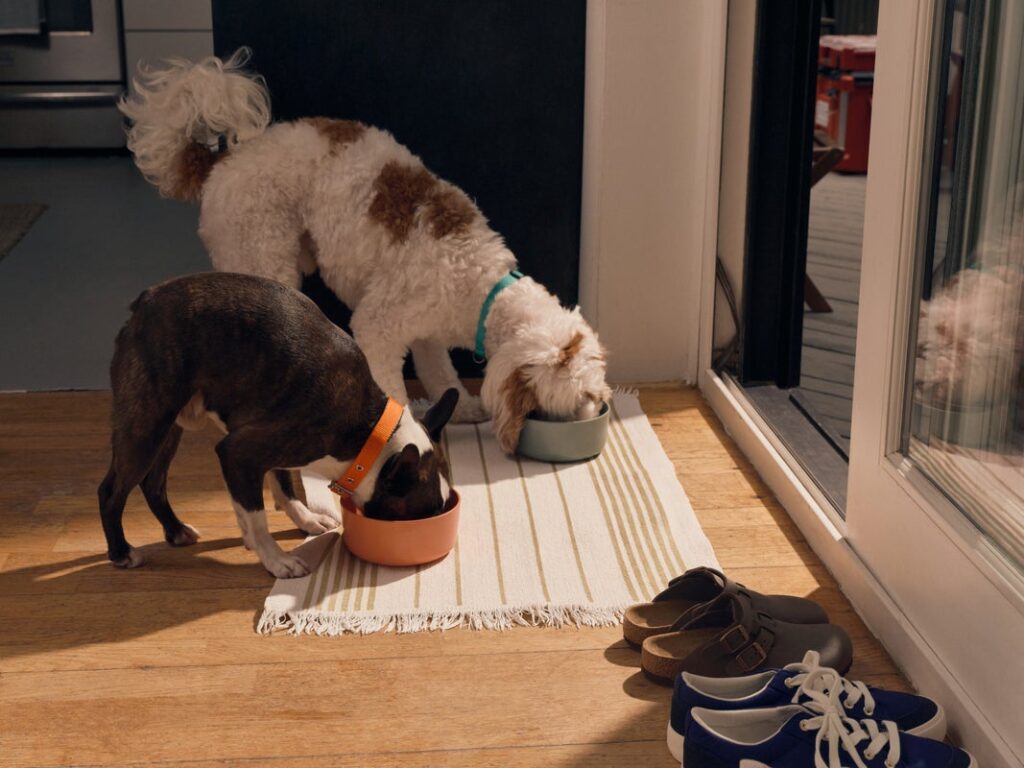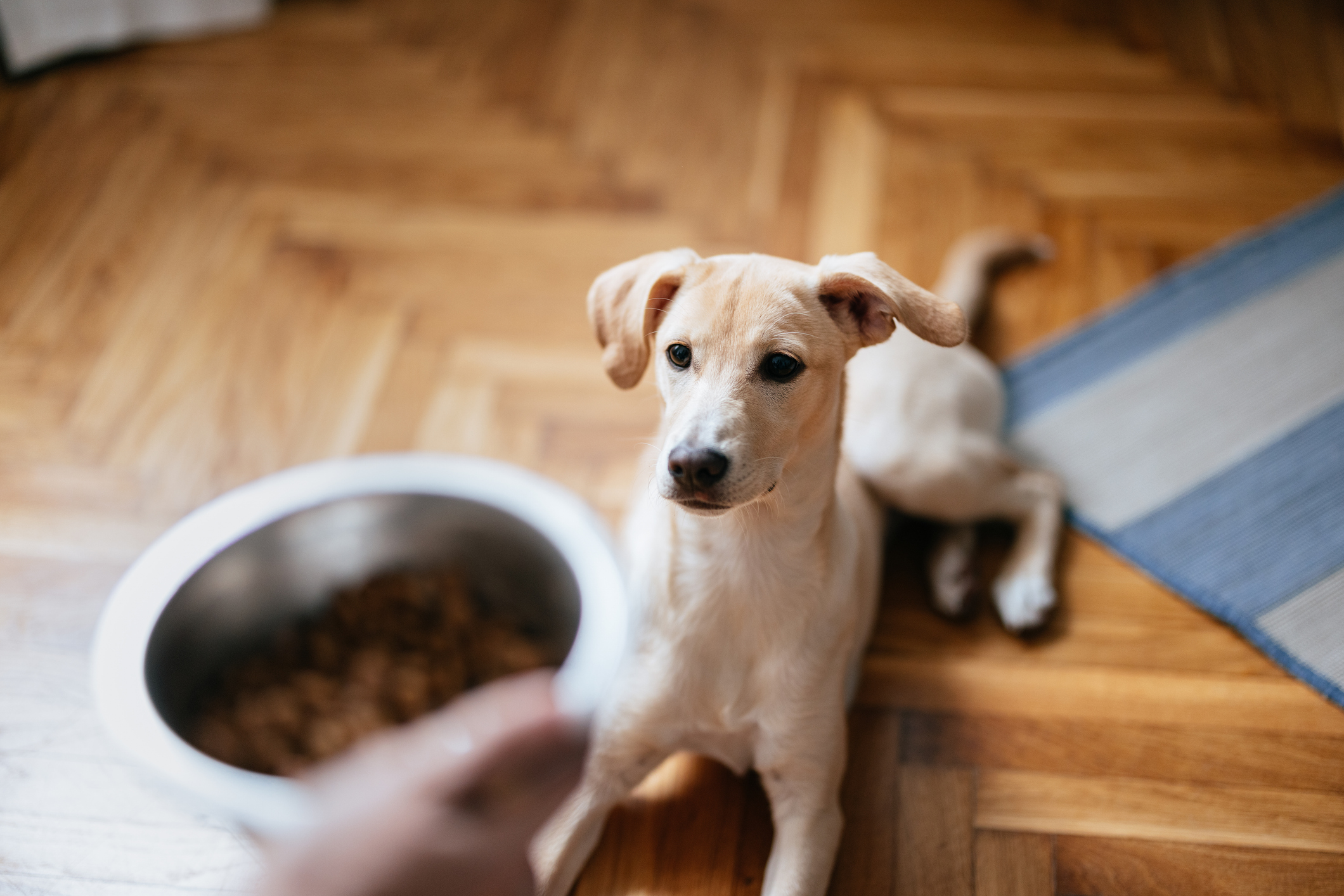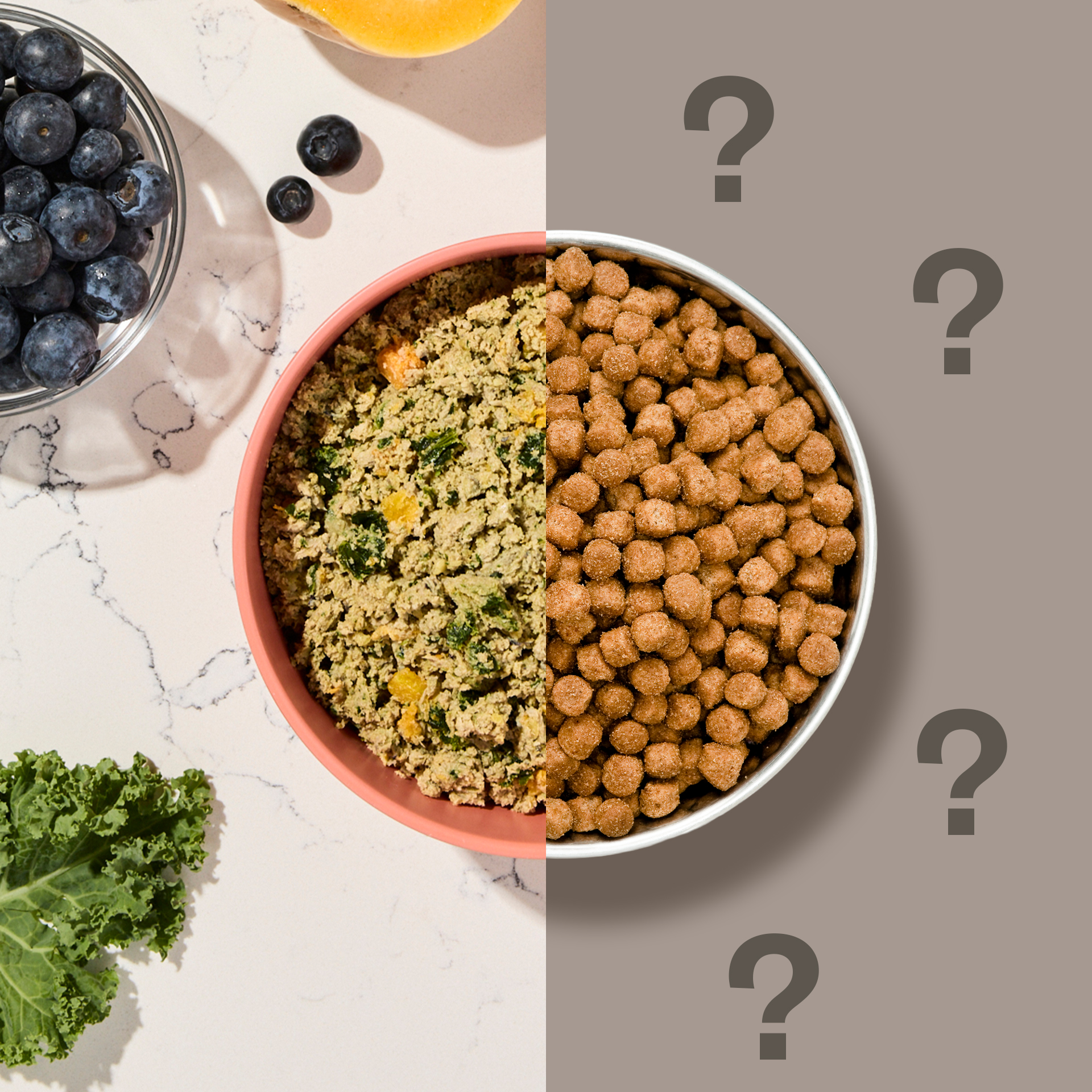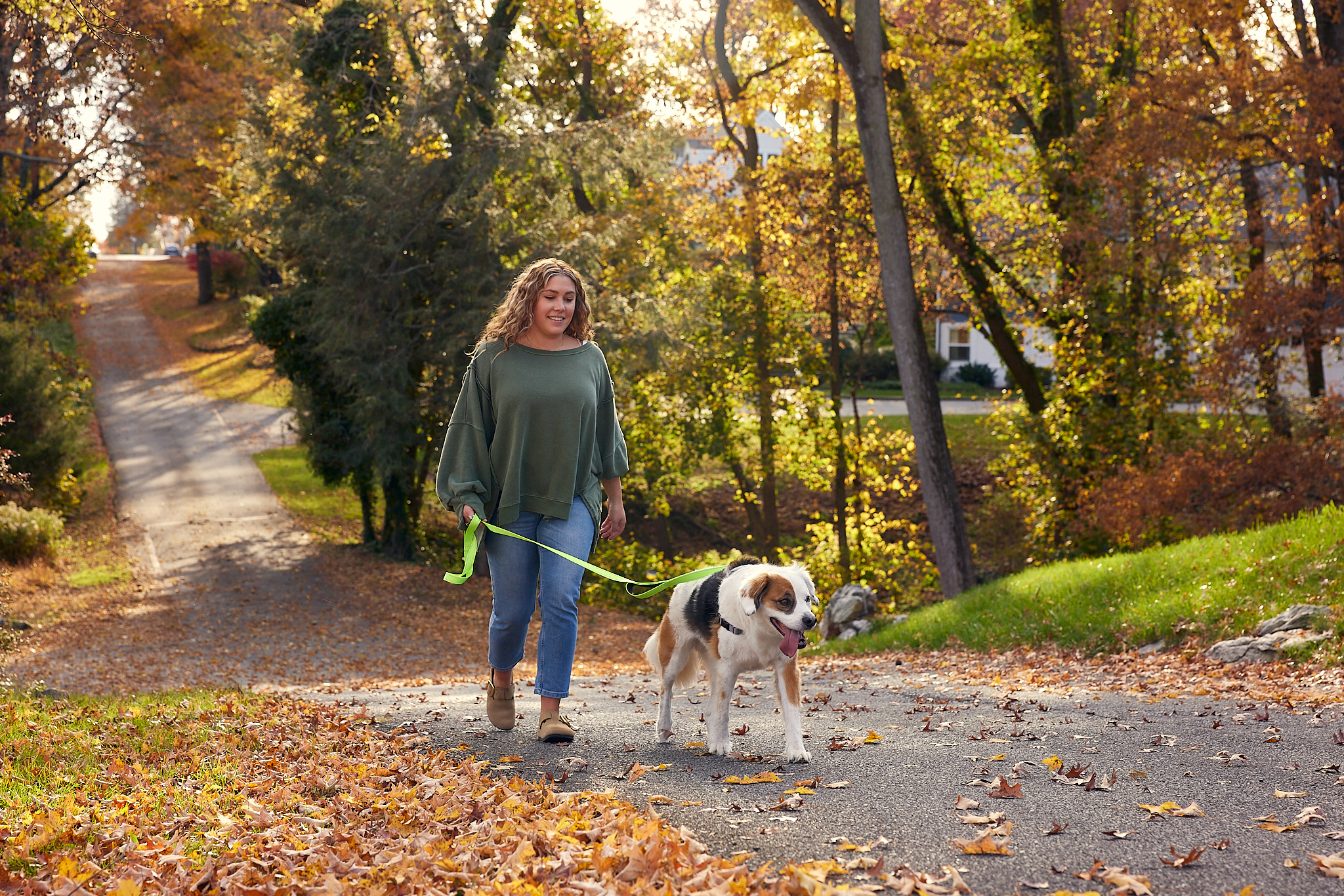Hey Ollie blog readers! We’re offering you an exclusive 60% OFF your starter box! Try now!
If you’ve ever caught your dog scratching nonstop, licking their paws raw, or rubbing their face on the carpet like it’s their job, you’re not alone. Dog allergies are one of the top reasons people end up at the vet.
From pollen to food ingredients to flea bites, dogs can be sensitive to all sorts of things — just like us. The problem is, your dog can’t tell you what’s causing the itch, and guessing wrong can drag out their discomfort (and yours).
So what can you actually do about it? For starters, don’t reach for human allergy meds without checking. Some can help, but not all of them are safe for dogs. The good news is, there are vet-approved options that can bring real relief, from the right antihistamines to fresh, clean food that supports healthy skin from the inside out.
This guide will break down what you can give your dog for allergies, which over-the-counter meds are safest, and when it’s time to get a vet’s help — plus how a balanced diet like Ollie gently cooked recipes can make a real difference for itchy pups.
Types of Allergies in Dogs
Not all allergies are created equal. Knowing what type you’re dealing with helps you take the right steps toward relief. Here’s a quick breakdown of the most common types:
- Environmental (seasonal): Caused by things like pollen, mold, or dust in the air — often worse in spring or fall
- Food sensitivities: Reactions to ingredients like chicken, beef, dairy, or grains
- Flea allergies: Triggered by flea bites — even one bite can cause intense itching in sensitive dogs
- Contact allergies: Caused by skin contact with things like grass, cleaning products, or certain fabrics
Some dogs have just one type, others have a mix. The good news? Once you know the source, you can take control — whether that means switching up food, adjusting your routine, or working with your vet.
Common Signs Your Dog Has Allergies
Dogs can’t say, “Hey, I’m allergic to this pollen,” but they do tell you in other ways. Knowing the signs helps you spot a problem before your dog’s scratching turns into raw skin or constant discomfort.
Here are some of the most common clues your dog might be dealing with allergies:
- Itchy skin — constant scratching, licking, or biting at paws, belly, or back legs
- Red or inflamed skin — hot spots, scabs, or hair loss in certain areas
- Licking and chewing paws — a big one for seasonal allergies or contact irritation
- Frequent ear infections — head shaking, scratching ears, or a yeasty smell
- Runny eyes or nose — mild sneezing or clear discharge, especially with pollen
- Scooting — some dogs with allergies get itchy rear ends
- Digestive issues — soft poop, extra gassy, or stomach upset if it’s food related
Some dogs have one or two mild signs, while others end up with a mix of skin, ears, and belly issues all at once. That’s why treating allergies usually means looking at the big picture: what your dog touches, breathes in, and eats every day.
If food is part of the problem, switching to a clean, gently cooked meal — like Ollie fresh recipes — can help reduce flare-ups and keep your dog more comfortable long-term.
What You Can Give Your Dog for Allergies (Vet-Approved Options)
When your dog’s itching, it’s tempting to grab the first allergy med in your cabinet. But not everything that works for humans is safe for dogs. The good news is, there are vet-approved ways to help.
Here’s what you can actually give your dog for allergies — and what to know before you do.
Safe Antihistamines for Dogs
For mild seasonal allergies, some over-the-counter human antihistamines can be safe for dogs when used correctly. Always check with your vet for the right dose.
- Benadryl (diphenhydramine): Often used for mild itching or hives.
- Claritin (loratadine): Another option for mild seasonal allergies. Make sure it’s plain Claritin — not Claritin-D, which is dangerous for dogs.
- Zyrtec (cetirizine): Sometimes recommended for itchiness.
These don’t work for every dog and usually help mild symptoms best.
Prescription Allergy Meds
If your dog’s itching is more intense or constant, your vet may suggest:
- Apoquel: A daily pill for dogs with moderate to severe itching.
- Cytopoint: An injection that can help break the itch cycle for weeks at a time.
- Steroids: Sometimes used short-term for severe flare-ups, but not a long-term fix.
Natural Allergy Relief
Some dogs benefit from extra skin support alongside meds:
- Oatmeal baths: Soothe irritated skin and wash away allergens.
- Coconut oil: Lightly rubbed on dry spots or paws.
- Omega-3 supplements: Help strengthen the skin barrier and calm inflammation.
And don’t forget — food matters too. Many itchy dogs have food sensitivities. Feeding a fresh, gently cooked diet like Ollie can help reduce triggers and support healthy skin from the inside out.

Can Food Help with Allergies?
A lot of itchy dogs aren’t just reacting to pollen or dust — they’re also reacting to what’s in their bowl. Food sensitivities and full-blown food allergies can show up as red skin, constant paw licking, ear infections, or even soft stool.
Many dogs with allergies benefit from a diet change. Here’s how the right food can help:
Fewer Triggers
Many commercial kibbles have fillers, preservatives, and common proteins like chicken or beef that some dogs just can’t handle. Switching to a simple, limited-ingredient diet makes it easier to figure out what your dog does and doesn’t tolerate.
Supports Skin Health
Real, gently cooked food packed with omega-3s, healthy fats, and clean protein can help strengthen your dog’s skin barrier. That means less dryness, less licking, and less scratching.
Helps You Spot the Culprit
Feeding fresh, balanced meals like Ollie recipes gives you more control over what’s going in your dog’s body — and what you might want to avoid in the future. No mystery ingredients, no guesswork.
If you suspect food is part of the allergy puzzle, talk to your vet about an elimination diet. They may suggest removing common triggers like chicken, wheat, or corn for a few weeks, then slowly reintroducing one thing at a time.
When you feed clean, balanced meals, your dog’s whole system works better — and other allergy treatments tend to work better too.
Over-the-Counter Dog Allergy Treatment: What’s Safe?
Pet parents ask this all the time: Can I just give my dog Benadryl or Claritin? The short answer is yes — but only under the right circumstances, and only in the right amount.
What’s Generally Safe
Benadryl, Claritin, and Zyrtec are the three most common human antihistamines vets may suggest for dogs. They’re usually safe for mild allergy symptoms like sneezing or mild itching. But always double-check:
- Use the plain version only. Claritin-D, which contains pseudoephedrine, is dangerous for dogs.
- No added ingredients. Skip liquid Benadryl with alcohol or other additives.
- Correct dose. Your vet can tell you exactly how much your dog needs based on their weight.
What Not to Give Dogs For Allergy Relief
Never give your dog human pain relievers or cold medicine for itching or swelling. Medications like ibuprofen, acetaminophen, or decongestants can be toxic for dogs, even in small amounts.
When OTC Alone Isn’t Enough
If your dog’s allergies are moderate to severe, or if they’re losing fur, breaking their skin open, or developing infections, over-the-counter pills won’t cut it. That’s when prescription treatments — and a closer look at diet and environment — really help.
Many dogs with allergies need a combo approach: safe meds, a clean living space, and fresh, simple food that doesn’t trigger more problems. That’s why so many pet parents switch to Ollie gently cooked meals when they’re trying to rule out food triggers.
When to Call the Vet
Sometimes a quick bath or a safe antihistamine is all your dog needs for mild seasonal itching. But not every allergy can be fixed at home. Knowing when it’s time to get your vet involved can save your dog from weeks of misery, and you from playing guessing games.
Here’s when you should pick up the phone:
Signs Home Treatment Isn’t Enough
Some allergy symptoms can be mild and short-lived — but if your dog’s itching or discomfort keeps coming back, that’s a red flag. Ongoing symptoms aren’t just “part of life” for sensitive dogs — they’re a sign your pup needs more support.
Call your vet if you notice:
- Your dog’s scratching so much they’re losing fur or creating open sores
- They have repeat ear infections or constant paw licking that never clears up
- There’s red, swollen skin or “hot spots” that ooze or smell bad
- Over-the-counter allergy meds don’t seem to help at all
- They’re having trouble breathing, have sudden swelling around the face, or develop hives — that’s an emergency
Getting ahead of chronic symptoms can prevent bigger issues down the line and help your dog feel more like themselves again.
How Vets Figure It Out
If your dog is constantly itchy, uncomfortable, or dealing with repeat infections, it’s not just “normal.” Chronic allergy symptoms are a sign that something deeper is going on — and your vet can help get to the bottom of it.
Your vet might run allergy tests to check for environmental triggers like pollen, dust mites, or mold. If food is suspected, there’s no simple blood test that can confirm a food allergy in dogs — most vets recommend an elimination diet as the most accurate way to pinpoint what’s causing the reaction.
They may also look for things that can make allergy symptoms worse, like fleas or secondary infections. The goal isn’t just to mask the itch — it’s to figure out what’s really causing it and help your dog feel better for the long haul.
Home Care Tips for Dogs with Allergies
Medications and diet changes help, but a few small daily habits can make a big difference for dogs who struggle with allergies. Think of these steps as backup support to keep the itch under control.
Wipe Those Paws
Pollen and dust love to hitch a ride on your dog’s feet. After walks, wipe your dog’s paws and belly with a damp cloth to help wash away what they pick up outside.
Use Gentle Baths
An oatmeal bath or a mild, vet-approved shampoo can help soothe itchy skin and wash off allergens. Just don’t overdo it, too many baths can dry out your dog’s skin.
Wash Bedding Often
Dog beds, blankets, and soft toys collect allergens and dander. Wash them regularly in hot water to cut down on triggers your dog comes in contact with every day.
Stay on Top of Flea Prevention
Even one flea bite can set off an allergic reaction in some dogs. Keep your dog on a flea prevention plan year-round to avoid extra scratching and skin flare-ups.
Feed a Consistent, Quality Diet
Stick to meals with real, recognizable ingredients. Skip unnecessary fillers that can irritate sensitive dogs. Many pet parents find that switching to Ollie fresh, gently cooked food helps manage food sensitivities and keeps skin healthier from the inside out.
Good home care helps your dog stay comfortable, and makes whatever allergy meds or treatments you’re using work better.
Try Ollie Fresh Dog Food Today!
FAQs About Allergy Medicine for Dogs
Can dogs take Claritin?
Yes, but only the plain version, without added decongestants. Claritin (loratadine) can help mild seasonal allergies in dogs but always check the dose with your vet first. Never give Claritin-D because it contains pseudoephedrine, which is dangerous for dogs.
Is Benadryl safe for dogs?
Benadryl (diphenhydramine) is one of the most common over-the-counter options for mild itching, but it doesn’t work for every dog and it can cause drowsiness. Talk to your vet for the right dose for your dog’s weight.
What’s the best allergy medicine for dogs long-term?
For long-term allergy control, vets often recommend prescription options like Apoquel or Cytopoint injections. These work better for ongoing, moderate to severe itching than antihistamines alone.
Are there natural ways to help my dog’s allergies?
Yes. Oatmeal baths, paw wipes, regular cleaning, and high-quality omega-3 supplements can help. Many dogs with food sensitivities also do better on a fresh, limited-ingredient diet like Ollie, which supports healthy skin and coat naturally.
Will my dog’s allergies ever go away?
Some seasonal allergies come and go, but many dogs have allergies for life. The good news is, with the right mix of vet care, safe meds, and everyday steps at home, you can keep your dog comfortable and itching to a minimum.
Tagged As:

The nutrition your dog needs,
the food they want.

Enjoying our articles? Subscribe our Newsletters and get new articles directly to your inbox
You might also like
12 August 2025
5 MINS READ
Top 8 Allergens Hiding in Your Dog’s Bowl
As pup parents, we never want to see our dogs uncomfortable. When it comes to itching, swelling, and upset stomachs, the culprit may be in their bowl. Understanding the most common allergens and t…
by Ollie Pets
11 August 2025
5 MINS READ
Not all Processing Is Equal: What’s Really in Your Pet’s Bowl?
As pet parents, we know how important it is that our dogs live long, healthy, and happy lives. This is why at Ollie, we focus so much on what goes into their bowls. But did you know there may be s…
31 July 2025
4 MINS READ
The Healthiest US States for Dogs
The Ollie Health team, a team of veterinarians and veterinary technicians, reviews thousands of photos submitted through Ollie’s Health Screening service. That’s hundreds of dogs (and their st…
by Ollie Pets







